Dynamic Mechanical Characteristics of Horseshoe Tunnel Subjected to Blasting and Confining Pressure
Abstract
1. Introduction
2. Materials and Numerical Modeling
2.1. Materials
2.2. Model Building
3. Dynamic Response with Different Blast Loading Direction
3.1. Dynamic Stress Field Propagation
3.2. Stress Concentration in Partial Damage
3.3. Stress Field in Back Surrounding Rocks with Different Loading Directions
3.4. Cracks Distribution by Loading Direction
4. Dynamic Response under Confining Pressure
4.1. Uniform Confining Pressure
4.2. Non-Uniform Confining Pressure
5. Conclusions
Author Contributions
Funding
Institutional Review Board Statement
Informed Consent Statement
Data Availability Statement
Acknowledgments
Conflicts of Interest
References
- Hajiabdolmajid, V.; Kaiser, P. Brittleness of rock and stability assessment in hard rock tunneling. Tunn. Undergr. Space Technol. 2003, 18, 35–48. [Google Scholar] [CrossRef]
- Read, R.S. 20 years of excavation response studies at AECL’s Underground Research Laboratory. Int. J. Rock Mech. Min. 2004, 41, 1251–1275. [Google Scholar] [CrossRef]
- He, C.; Yang, J.; Yu, Q. Laboratory study on the dynamic response of rock under blast loading with active confining pressure. Int. J. Rock Mech. Min. 2018, 102, 101–108. [Google Scholar] [CrossRef]
- Lou, P.; Huang, W.; Huang, X. Analysis of Shield Tunnels Undercrossing an Existing Building and Tunnel Reinforcement Measures. Appl. Sci. 2023, 13, 5729. [Google Scholar] [CrossRef]
- Banadaki, M.D. Stress-Wave Induced Fracture in Rock due to Explosive Action. Master’s Thesis, University of Toronto, Toronto, ON, Canada, 2010. [Google Scholar]
- Martini, C.D.; Read, R.S.; Martino, J.B. Observations of brittle failure around a circular test tunnel. Int. J. Rock Mech. Min. 1997, 34, 1065–1073. [Google Scholar] [CrossRef]
- Yang, R.S.; Ding, C.X.; Yang, L.Y.; Lei, Z.; Zhang, Z.R.; Wang, Y.B. Visualizing the blast-induced stress wave and blasting gas action effects using digital image correlation. Int. J. Rock Mech. Min. 2018, 112, 47–54. [Google Scholar] [CrossRef]
- Gong, F.; Wu, W.; Li, T.; Si, X.F. Experimental simulation and investigation of spalling failure of rectangular tunnel under different three-dimensional stress states. Int. J. Rock Mech. Min. 2019, 122, 104081. [Google Scholar] [CrossRef]
- Yan, G.; Yang, Q.; Zhang, F.; Hao, Q.; Wang, X.; Wang, H. Experimental Study on the Effects of In Situ Stress on the Initiation and Propagation of Cracks during Hard Rock Blasting. Appl. Sci. 2021, 11, 11169. [Google Scholar] [CrossRef]
- Zhou, L.; Zhu, Z.; Qiu, H.; Zhang, X.; Long, L. Study of the effect of loading rates on crack propagation velocity and rock fracture toughness using cracked tunnel specimens. Int. J. Rock Mech. Min. 2018, 112, 25–34. [Google Scholar] [CrossRef]
- Simha, K.R.Y.; Fourney, W.L.; Dick, R.D. Studies on explosively driven cracks under confining in-situ stresses. In Proceedings of the 25th U.S. Symposium on Rock Mechanics (USRMS), Evanston, IL, USA, 25–27 June 1984. [Google Scholar]
- Su, G.; Feng, X.; Wang, J.; Jiang, J.Q.; Hu, L.H. Experimental study of remotely triggered rockburst induced by a tunnel axial dynamic disturbance under true-triaxial conditions. Rock Mech. Rock Eng. 2017, 50, 2207–2226. [Google Scholar] [CrossRef]
- Weng, L.; Li, X.; Taheri, A.; Wu, Q.H.; Xie, X.F. Fracture evolution around a cavity in brittle rock under uniaxial compression and coupled static–dynamic loads. Rock Mech. Rock Eng. 2018, 51, 531–545. [Google Scholar] [CrossRef]
- Li, X.H.; Zhu, Z.M.; Wang, M.; Xiao, D.J.; Shu, Y.; Deng, S. Fracture mechanism of rock around a tunnel-shaped cavity with interconnected cracks under blasting stress waves. Int. J. Impact Eng. 2021, 157, 103999. [Google Scholar] [CrossRef]
- Li, X.H.; Zhu, Z.M.; Wang, M.; Shu, Y.; Xiao, D.J. Influence of blasting load directions on tunnel stability in fractured rock mass. J. Rock Mech Geotech. Eng. 2022, 14, 346–365. [Google Scholar] [CrossRef]
- Wang, S.; Li, X.; Du, K.; Wang, S.; Tao, M. Experimental study of the triaxial strength properties of hollow cylindrical granite specimens under coupled external and internal confining stresses. Rock Mech. Rock Eng. 2018, 51, 2015–2031. [Google Scholar] [CrossRef]
- Yang, S.Q. Fracturing mechanism of compressed hollow-cylinder sandstone evaluated by X-ray micro-CT scanning. Rock Mech. Rock Eng. 2018, 51, 2033–2053. [Google Scholar] [CrossRef]
- Xu, M.F.; Wu, S.C.; Gao, Y.T.; Ma, J.; Wu, Q.L. Analytical elastic stress solution and plastic zone estimation for a pressure-relief circular tunnel using complex variable methods. Tunn. Undergr. Space Technol. 2018, 84, 381–398. [Google Scholar] [CrossRef]
- Abdellah, W.R.; Haridy, A.K.A.; Mohamed, A.K.; Kim, J.G.; Ali, M.A.M. Behaviour of Horseshoe-Shaped Tunnel Subjected to Different In Situ Stress Fields. Appl. Sci. 2022, 12, 5399. [Google Scholar] [CrossRef]
- Liu, R.; Yang, J.; Du, Y.; Li, M. Influence of Blasting Disturbance on the Dynamic Stress Distribution and Fracture Area of Rock Tunnels. Appl. Sci. 2023, 13, 5503. [Google Scholar] [CrossRef]
- Yang, Z.; Zhou, L.; Zhou, C.; Zhu, Z.; Wang, H.; Liu, Z.; Wang, C. Research on the dynamic failure behavior of fissured tunnel subjected to combined dynamic and static loads. Theor. Appl. Fract. Mec. 2023, 124, 103780. [Google Scholar] [CrossRef]
- Wang, S.Y.; Sloan, S.W.; Tang, C.A.; Zhu, W.C. Numerical simulation of the failure mechanism of circular tunnels in transversely isotropic rock masses. Tunn. Undergr. Space Technol. 2012, 32, 231–244. [Google Scholar] [CrossRef]
- Zhu, Z.; Xie, H.; Mohanty, B. Numerical investigation of blasting-induced damage in cylindrical rocks. Int. J. Rock Mech. Min. 2008, 45, 111–121. [Google Scholar] [CrossRef]
- Lisjak, A.; Figi, D.; Grasselli, G. Fracture development around deep underground excavations: Insights from FDEM modelling. J. Rock Mech. Geotech. 2014, 6, 493–505. [Google Scholar] [CrossRef]
- Li, S.C.; Feng, X.D. Numerical model for the zonal disintegration of the rock mass around deep underground workings. Theor. Appl. Fract. Mec. 2013, 67, 65–73. [Google Scholar] [CrossRef]
- Kirzhner, F.; Rosenhouse, G. Numerical analysis of tunnel dynamic response to earth motions. Tunn. Undergr. Space Technol. 2000, 15, 249–258. [Google Scholar] [CrossRef]
- Peng, L.; Hu, X.; Su, G.; Qin, Z.; Lu, H.; He, B. Cracking characteristics of the surrounding rocks of a hydraulic tunnel under high geothermal conditions: A model test. Rock Mech. Rock Eng. 2021, 54, 1369–1390. [Google Scholar] [CrossRef]
- Fan, Z.; Cai, J. Effects of unidirectional in situ stress on crack propagation of a jointed rock mass subjected to stress wave. Shock Vib. 2021, 2021, 5529540. [Google Scholar] [CrossRef]
- An, L.; Suorineni, F.T.; Xu, S.; Li, Y.-H.; Wang, Z.-C. A feasibility study on confinement effect on blasting performance in narrow vein mining through numerical modelling. Int. J. Rock Mech. Min. 2018, 112, 84–94. [Google Scholar] [CrossRef]
- Holmquist, T.J.; Templeton, D.W.; Bishnoi, K.D. Constitutive modeling of aluminum nitride for large strain, high-strain rate, and high-pressure applications. Int. J. Impact Eng. 2001, 25, 211–231. [Google Scholar] [CrossRef]
- Holmquist, T.J.; Johnson, G.R. A computational constitutive model for glass subjected to large strains, high strain rates and high pressures. Int. J. Appl. Mech. 2011, 78, 051003. [Google Scholar] [CrossRef]
- Shi, X.; Tao, Z.; Meng, Y. Calculation and verification for Johnson-Holmquist constitutive model parameters of tight sandstone. Chin. J. Rock Mech. Eng. 2015, 34, 3750–3758. [Google Scholar]
- Xiong, Y.B.; Hu, Y.L.; Xu, J.; Chen, J.J. Determining failure surface parameters of the Johnson-Holmquist concrete constitutive model. Acta Armamentarii 2010, 31, 746–751. [Google Scholar]
- Fukuda, D.; Mohammadnejad, M.; Liu, H.; Zhang, Q.; Zhao, J.; Dehkhoda, S. Development of a 3d hybrid finite-discrete element simulator based on gpgpu-parallelized computation for modelling rock fracturing under quasi-static and dynamic loading conditions. Rock Mech. Rock Eng. 2020, 53, 1079–1112. [Google Scholar] [CrossRef]
- Zhang, S.R.; Li, H.B.; Wang, G.H.; Kong, Y. A method to determine mesh size in numerical simulation of shock wave of underwater explosion. Vib. Shock 2015, 34, 93–100. [Google Scholar]
- Wang, H.B.; Zhang, H.B.; Tian, Z.; Ou, Z.C.; Zhou, G. Mesh Size Efiect and Its Mechanism Research in Numerical Calculation of Rock Dynamics. Acta Armamentarii 2016, 37, 1828–1836. [Google Scholar]
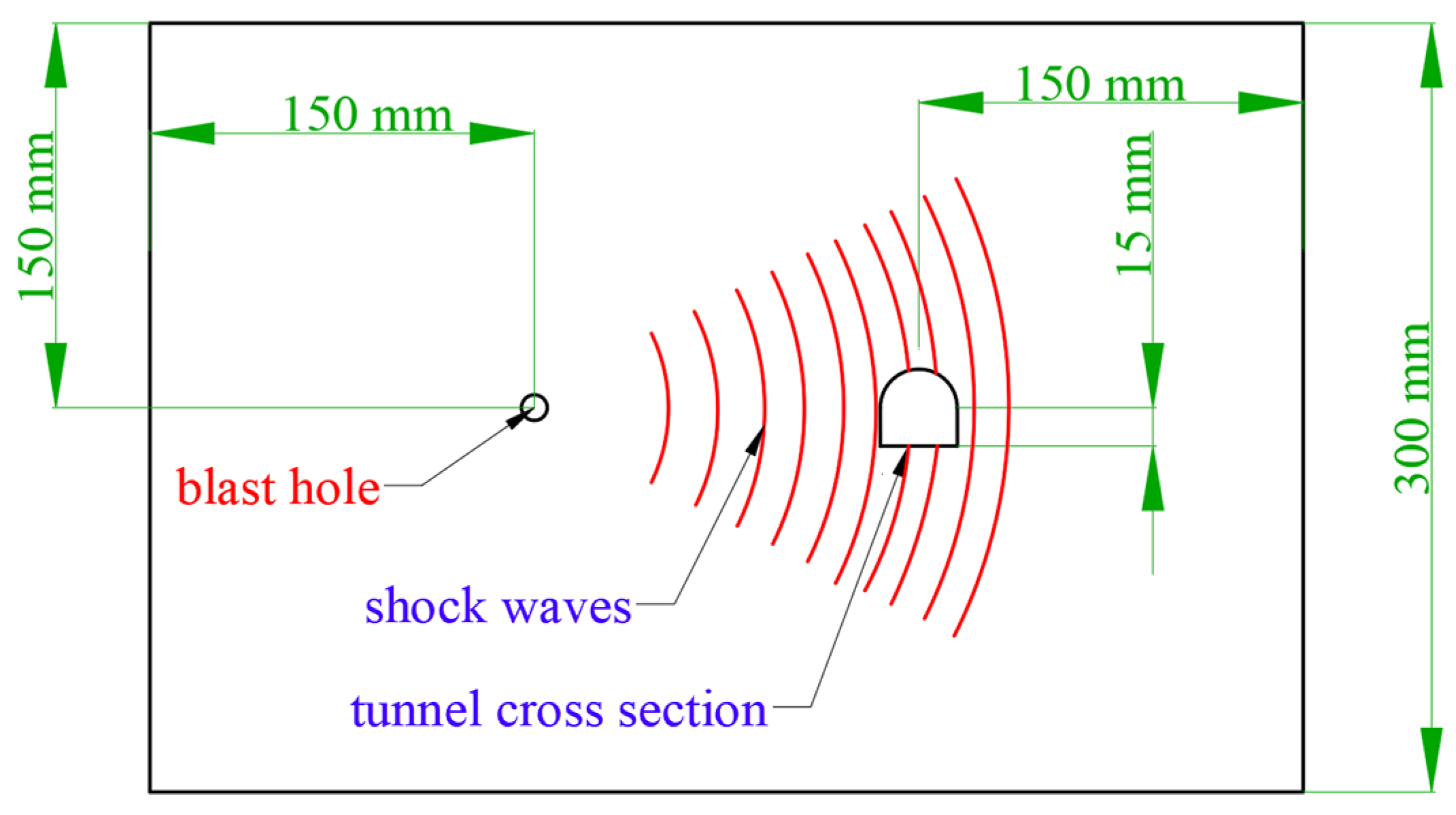


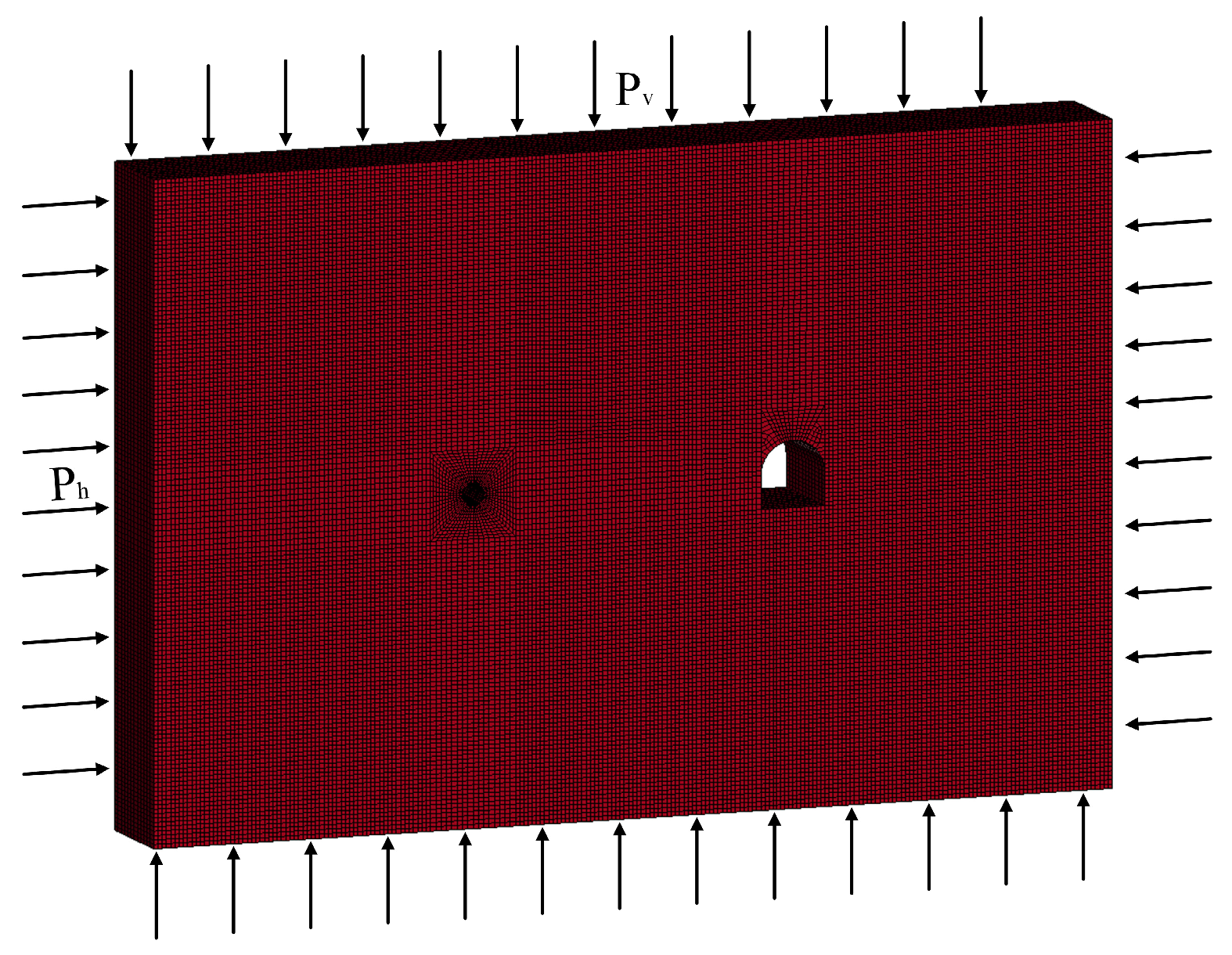
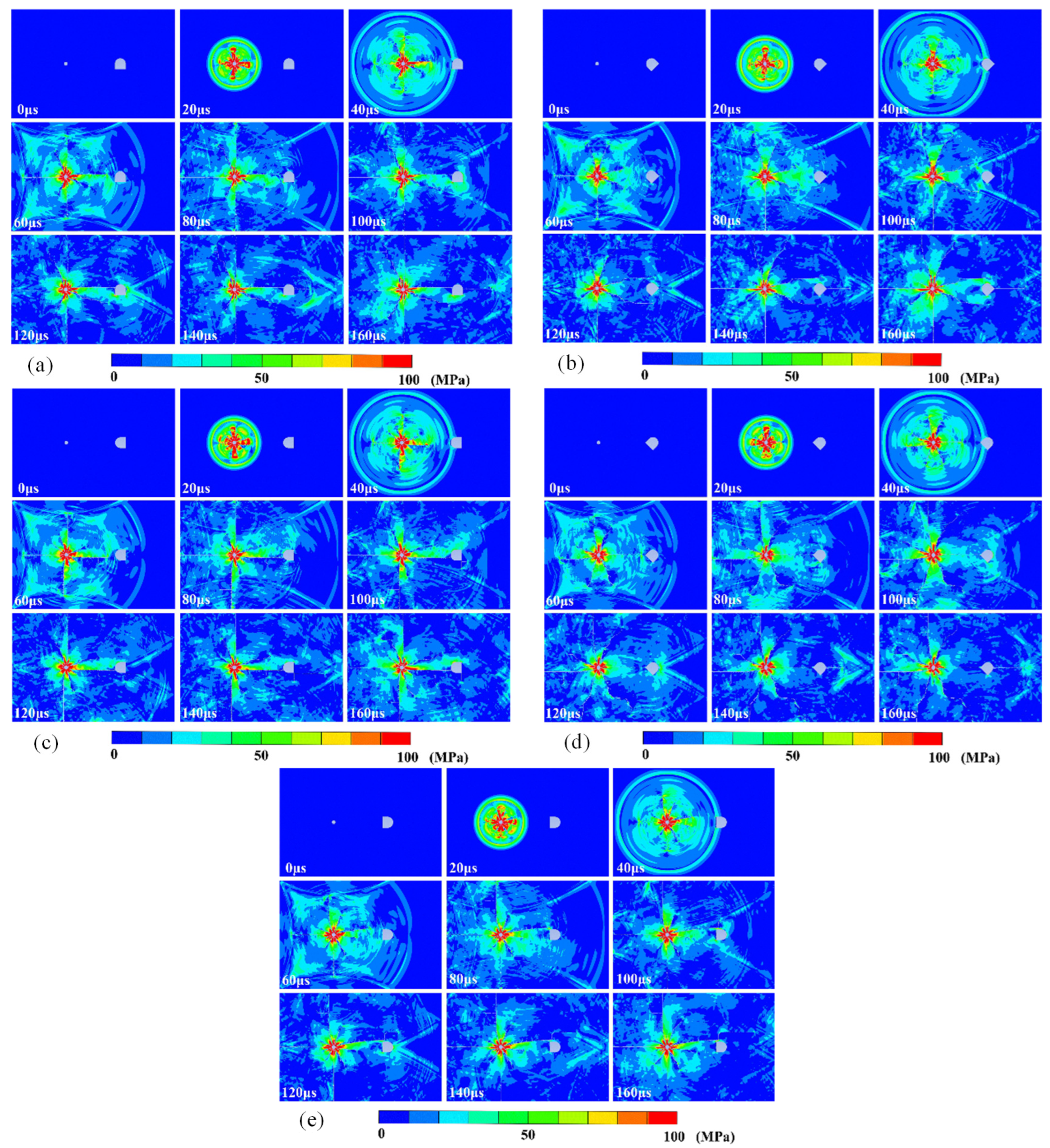
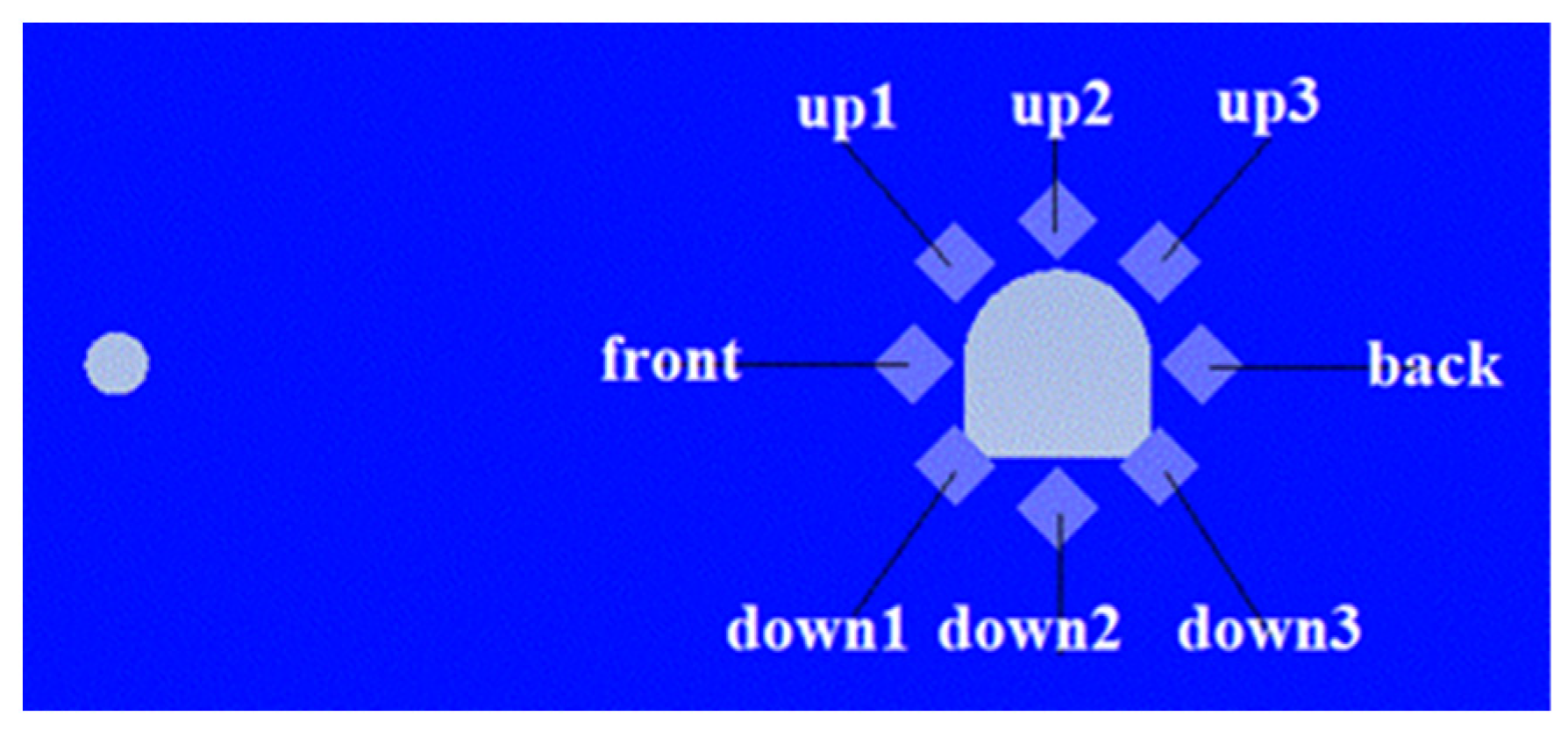
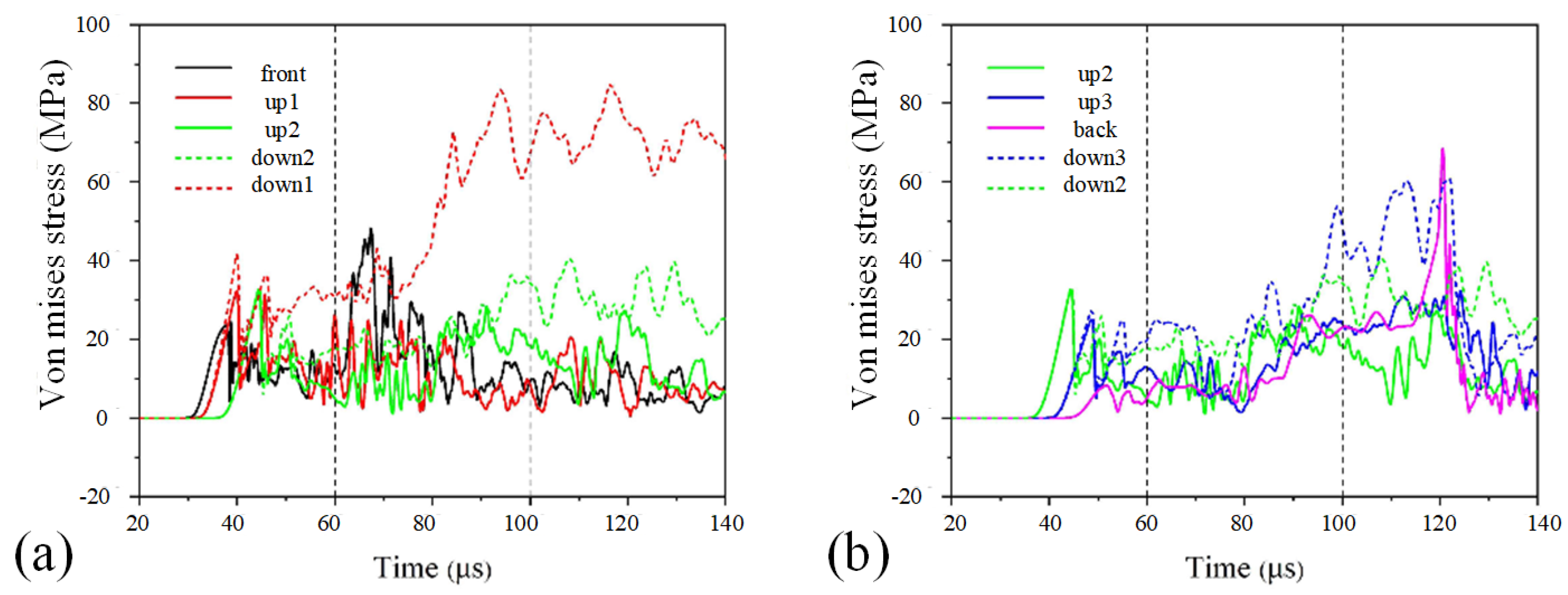
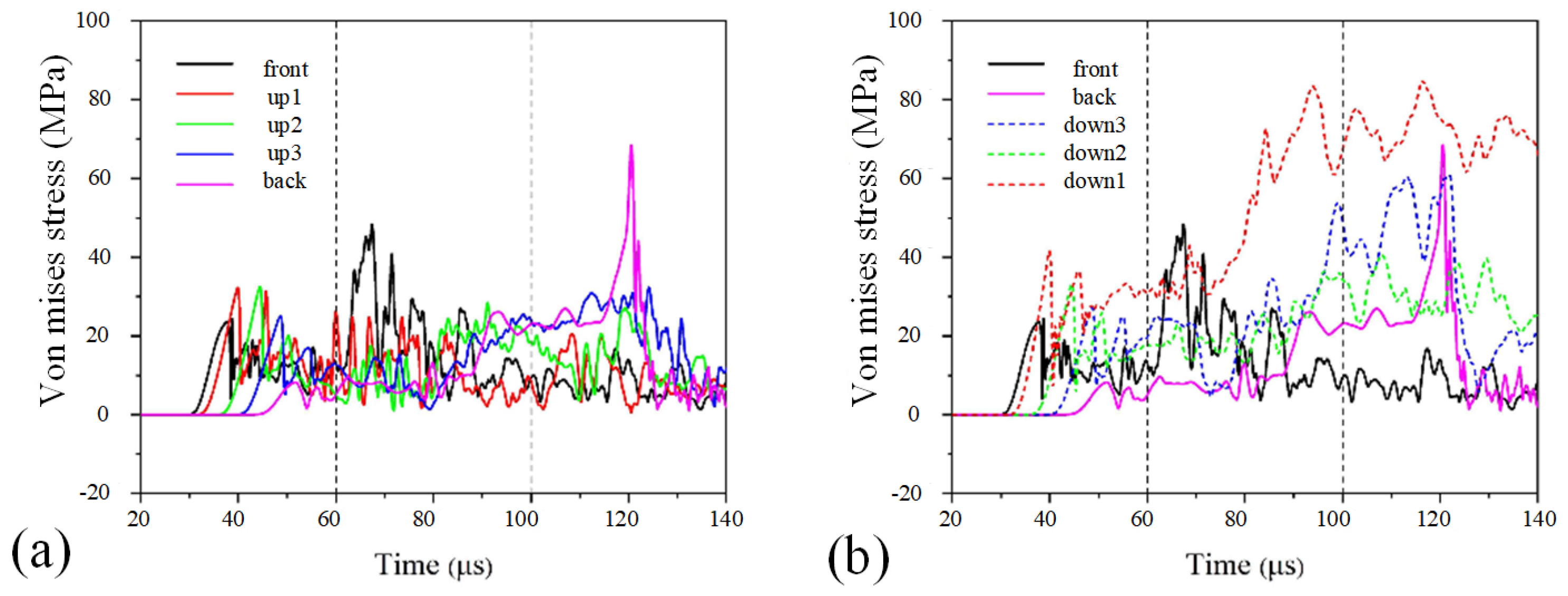

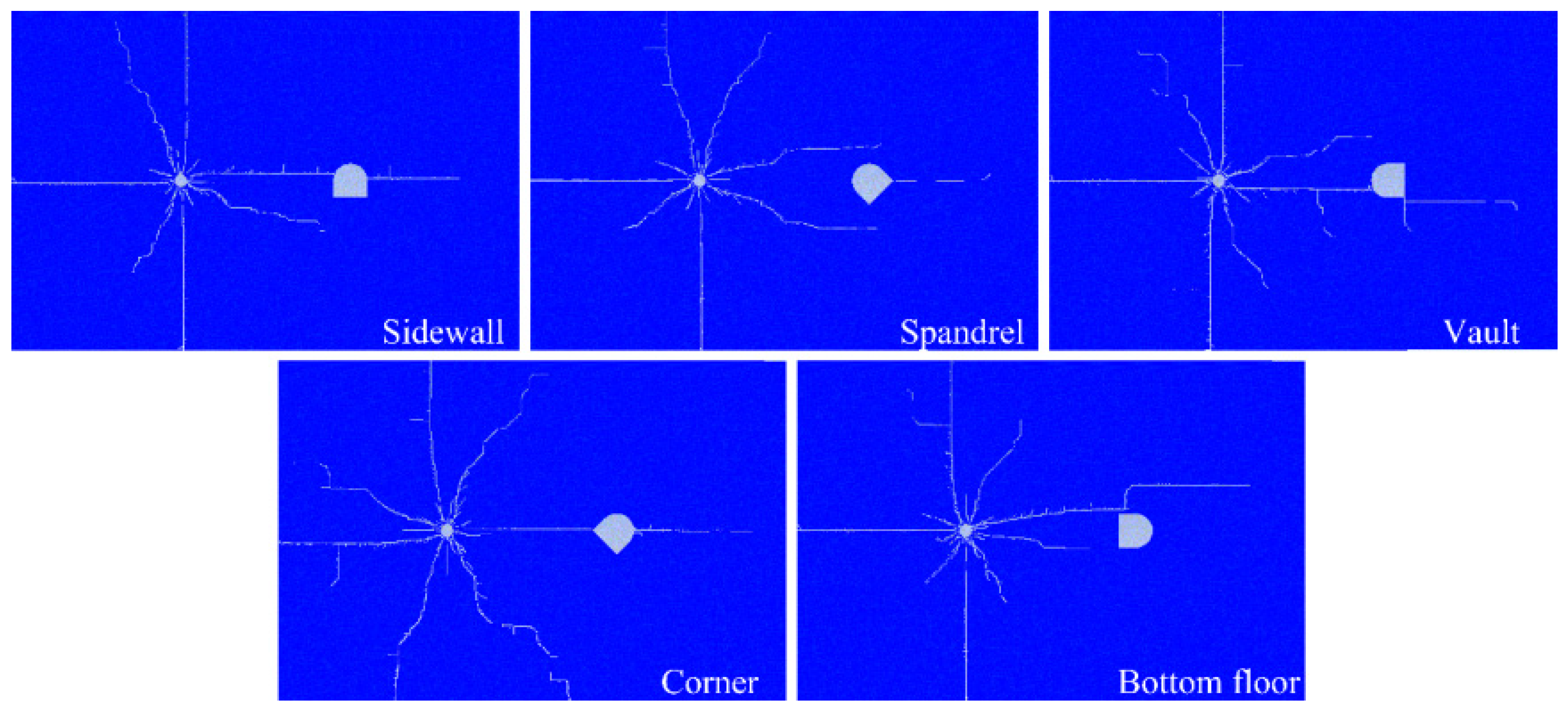
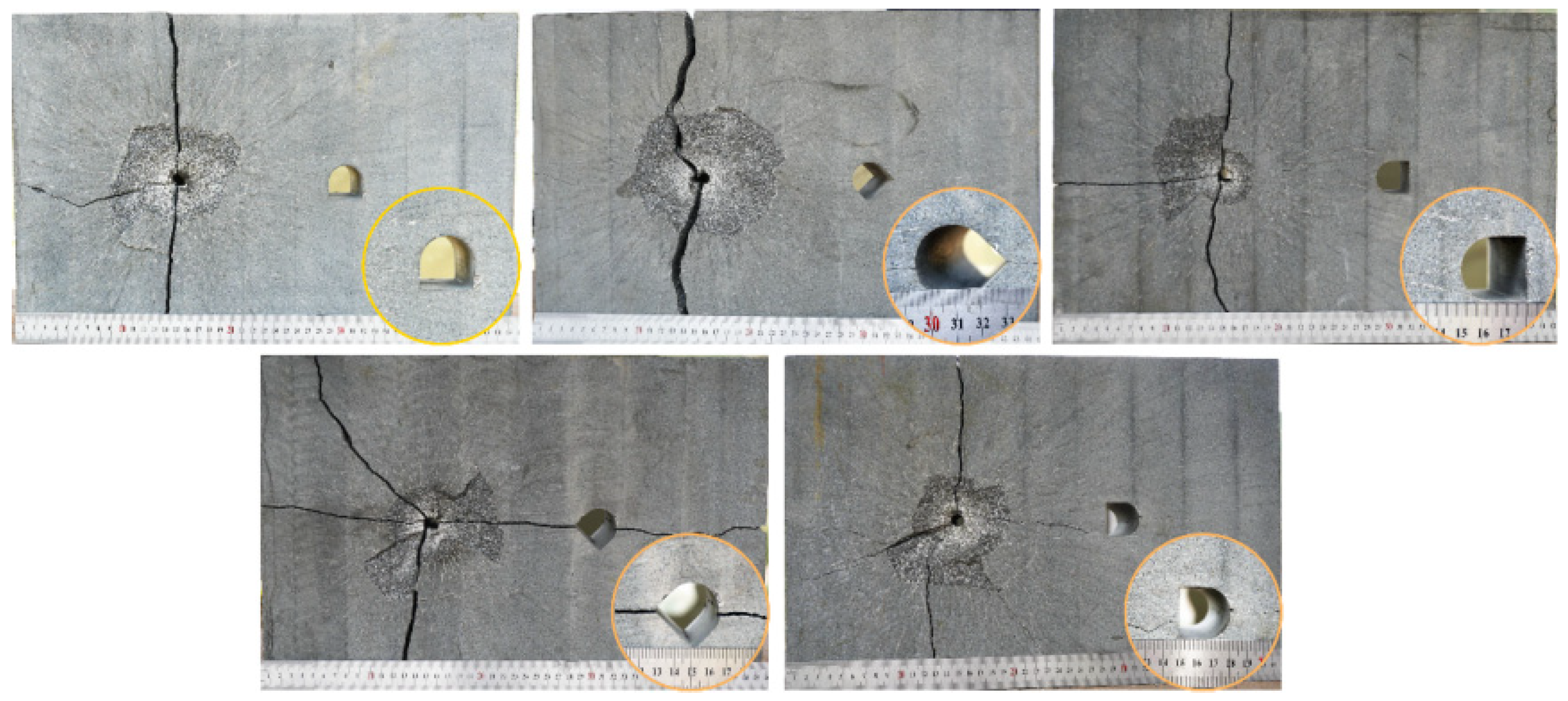
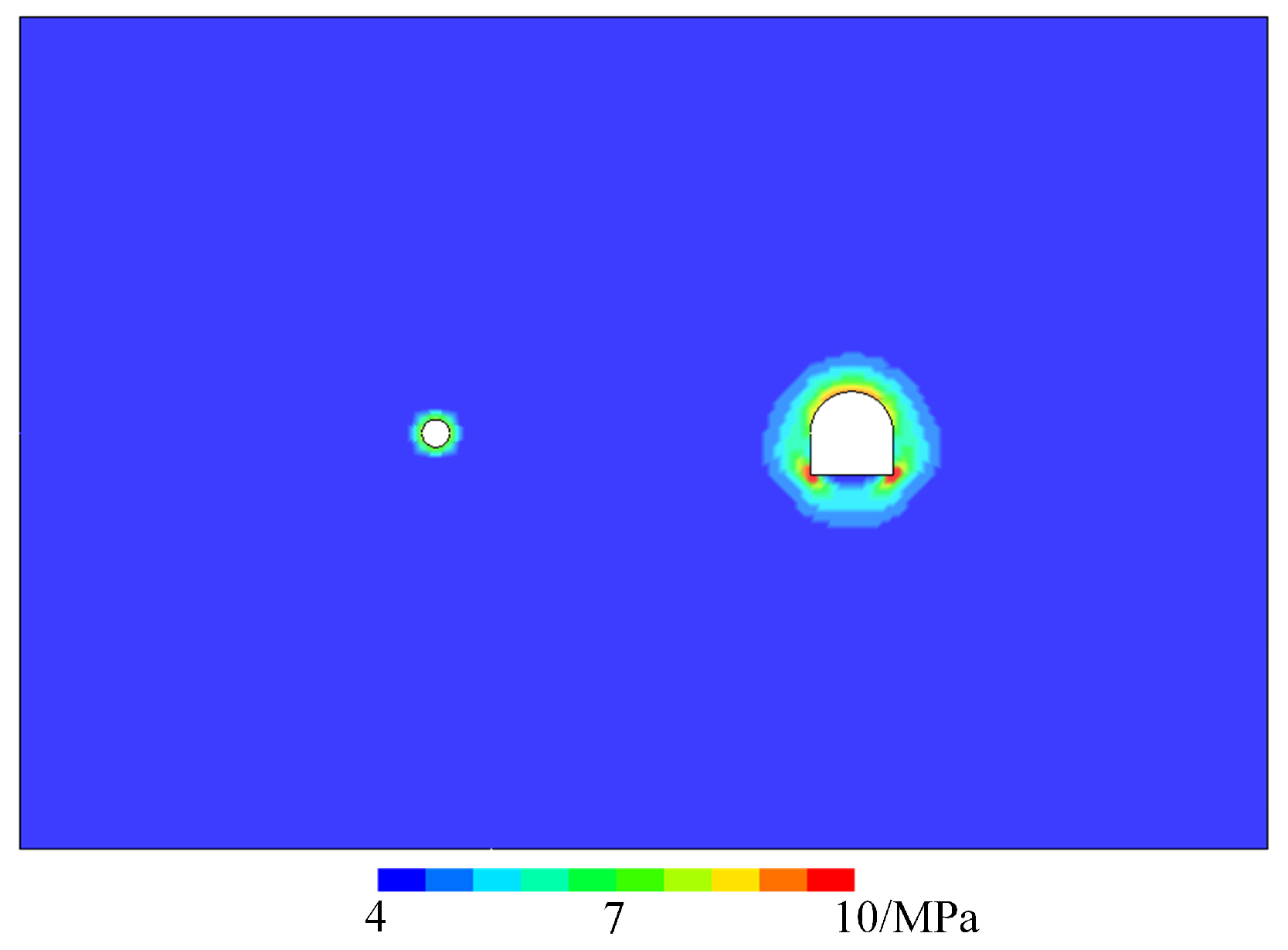
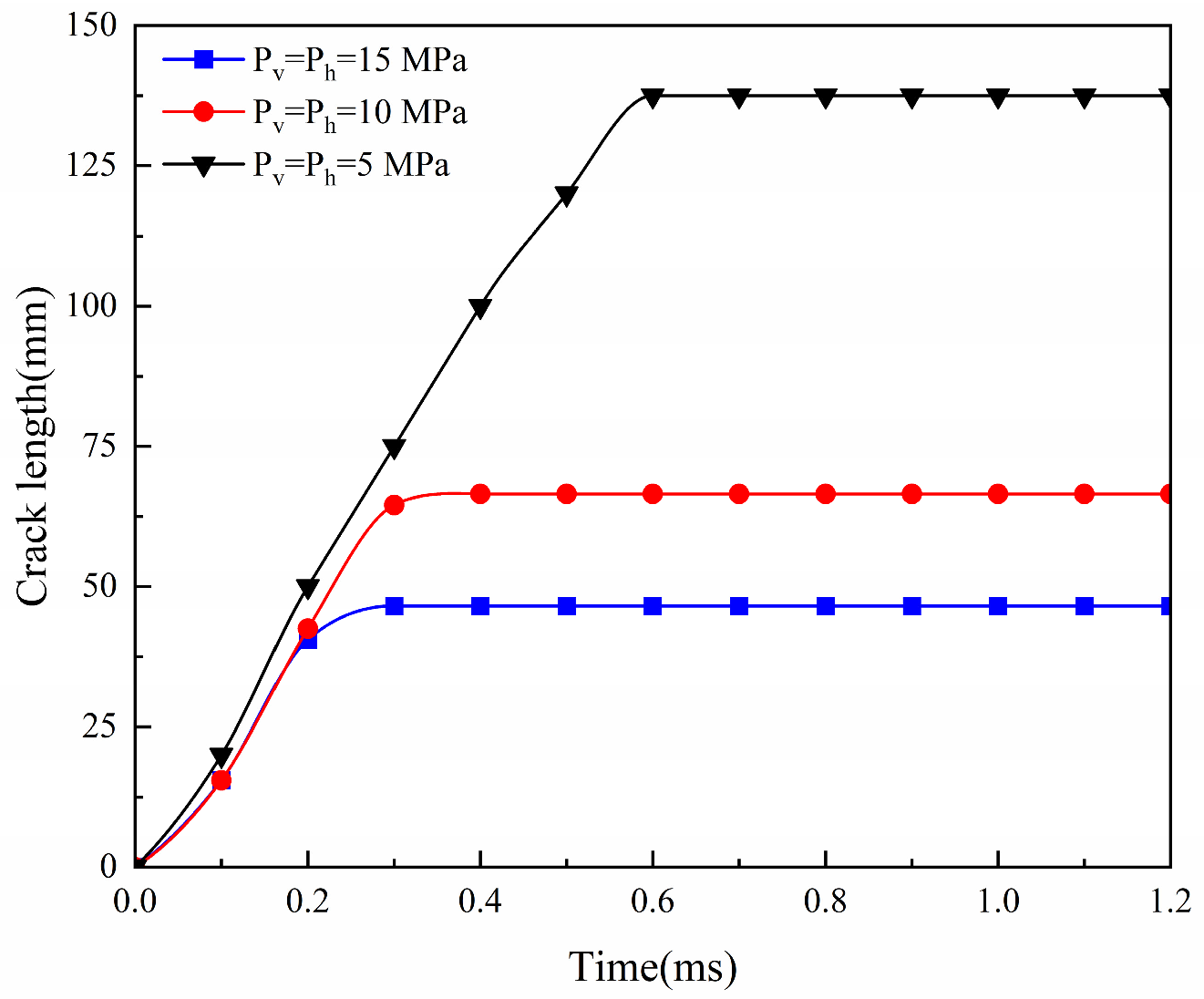


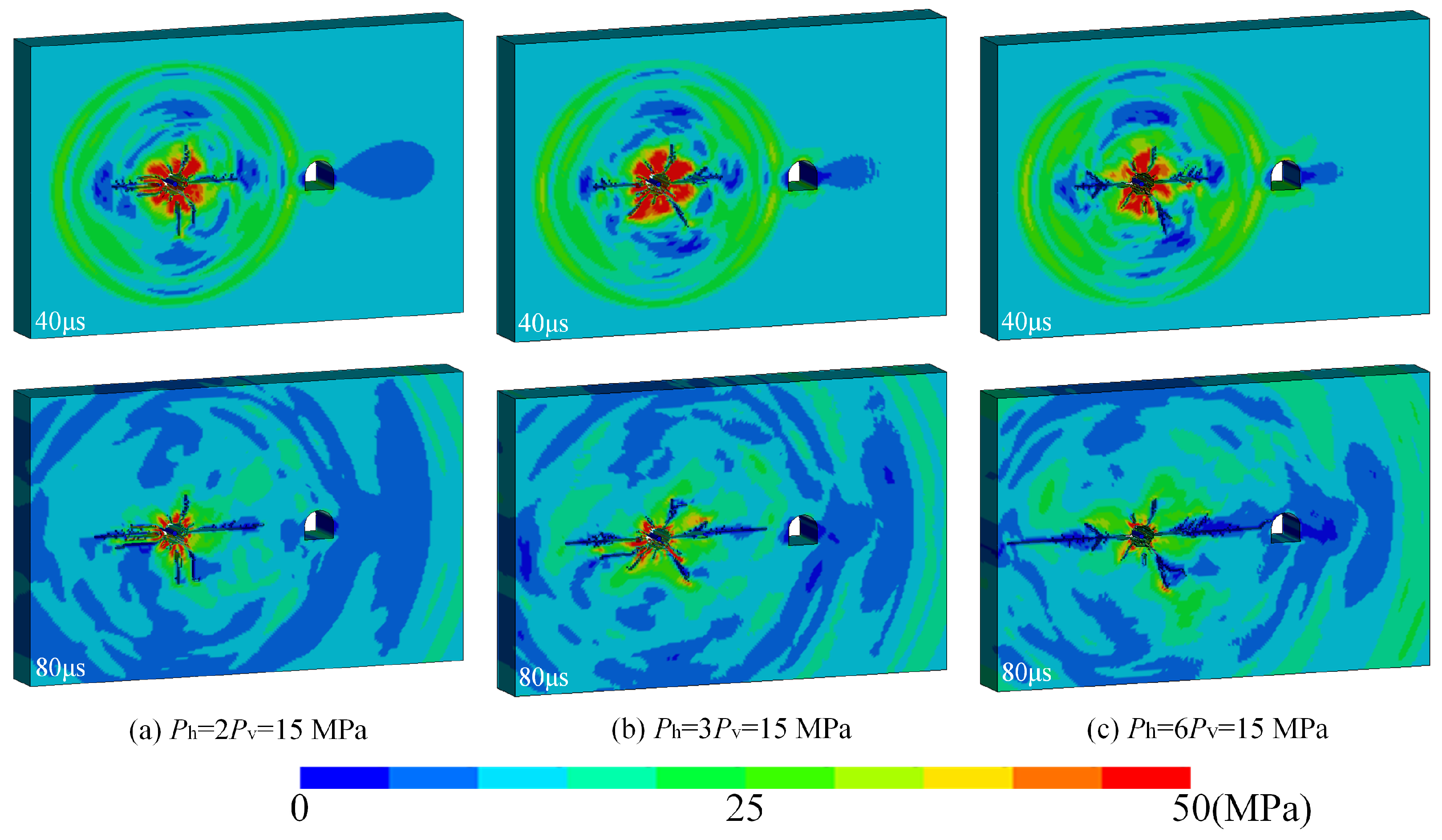
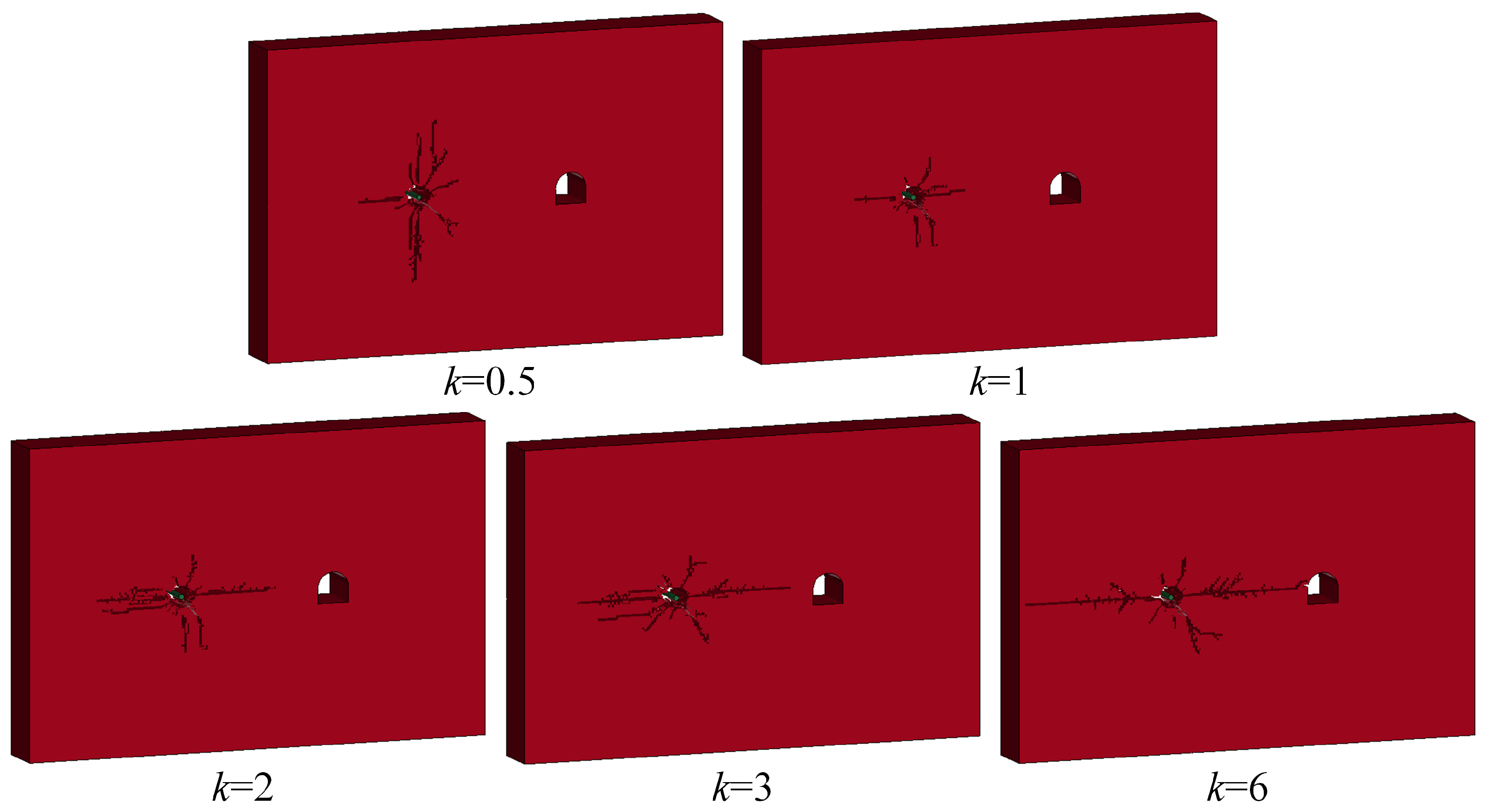
| Parameters | Unit | Value |
|---|---|---|
| Density | g/cm3 | 3.02 |
| Poisson’s ratio | 0.17 | |
| Young’s modulus | GPa | 37.61 |
| Tensile strength | MPa | 7.64 |
| Compressive strength | MPa | 86.62 |
| Parameters | Unit | Value | |
|---|---|---|---|
| Reference density | ρ0 | (g/cm3) | 3.02 |
| Bulk modulus | K1 | (GPa) | 18.99 |
| Polynomial EOS constant | K2 | (GPa) | −4500 |
| Polynomial EOS constant | K3 | (GPa) | 300,000 |
| Shear modulus | G | (GPa) | 16.07 |
| Hugoniot Elastic Limit | HEL | (GPa) | 4.17 |
| Intact Strength Constant | A | 0.97 | |
| Intact Strength Exponent | N | 0.64 | |
| Strain Rate Constant | C | 0.005 | |
| Fractured Strength Constant | B | 0.32 | |
| Fractured Strength Exponent | M | 0.64 | |
| Max. Fractured Strength Ratio | σ*FMax | 0.25 | |
| Johnson—Holmquist failure model | |||
| Hydro Tensile Limit | HTL | (GPa) | 50.26 |
| Damage constant | D1 | 0.005 | |
| Damage constant | D2 | 0.70 | |
| Bulking constant | β | 0.50 | |
| Type of tensile failure | Hydro |
| Confining Pressure | Ph/MPa | Pv/MPa | k = Ph/Pv |
|---|---|---|---|
| Uniform confining pressure | 5 | 5 | 1 |
| 10 | 10 | 1 | |
| 15 | 15 | 1 | |
| Non-uniform rock pressure | 15 | 2.5 | 6 |
| 15 | 5 | 3 | |
| 15 | 7.5 | 2 |
Disclaimer/Publisher’s Note: The statements, opinions and data contained in all publications are solely those of the individual author(s) and contributor(s) and not of MDPI and/or the editor(s). MDPI and/or the editor(s) disclaim responsibility for any injury to people or property resulting from any ideas, methods, instructions or products referred to in the content. |
© 2023 by the authors. Licensee MDPI, Basel, Switzerland. This article is an open access article distributed under the terms and conditions of the Creative Commons Attribution (CC BY) license (https://creativecommons.org/licenses/by/4.0/).
Share and Cite
He, C.; Yao, Y.; Liu, Y.; Mao, X.; Chen, Q. Dynamic Mechanical Characteristics of Horseshoe Tunnel Subjected to Blasting and Confining Pressure. Appl. Sci. 2023, 13, 8911. https://doi.org/10.3390/app13158911
He C, Yao Y, Liu Y, Mao X, Chen Q. Dynamic Mechanical Characteristics of Horseshoe Tunnel Subjected to Blasting and Confining Pressure. Applied Sciences. 2023; 13(15):8911. https://doi.org/10.3390/app13158911
Chicago/Turabian StyleHe, Chenglong, Yingkang Yao, Yaqing Liu, Xiang Mao, and Qihui Chen. 2023. "Dynamic Mechanical Characteristics of Horseshoe Tunnel Subjected to Blasting and Confining Pressure" Applied Sciences 13, no. 15: 8911. https://doi.org/10.3390/app13158911
APA StyleHe, C., Yao, Y., Liu, Y., Mao, X., & Chen, Q. (2023). Dynamic Mechanical Characteristics of Horseshoe Tunnel Subjected to Blasting and Confining Pressure. Applied Sciences, 13(15), 8911. https://doi.org/10.3390/app13158911






